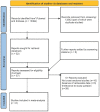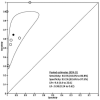The diagnostic accuracy of carbon monoxide pulse oximetry in adults with suspected acute carbon monoxide poisoning: a systematic review and meta-analysis
- PMID: 38223786
- PMCID: PMC10786445
- DOI: 10.3389/fmed.2023.1250845
The diagnostic accuracy of carbon monoxide pulse oximetry in adults with suspected acute carbon monoxide poisoning: a systematic review and meta-analysis
Abstract
Introduction: Acute carbon monoxide poisoning (COP) is one of the leading causes of intoxication among patients presenting to the emergency department (ED). COP symptoms are not always specific and may vary from mild to critical. In the last few years, COHb pulse oximeters have been developed and applied to the setting of suspected COP. The aim of this systematic review is to assess the diagnostic accuracy of CO pulse oximetry (SpCO) with carboxyhemoglobin (COHb) levels measured by blood gas analysis, used as a reference standard, in patients with suspected COP.
Methods: We developed our search strategy according to the PICOS framework, population, index/intervention, comparison, outcome, and study, considering the diagnostic accuracy of SpCO compared to COHb levels measured by blood gas analysis, used as a reference standard, in patients with suspected COP enrolled in cross-sectional studies in English. The search was performed on MEDLINE/PubMed and EMBASE in February 2022. Quality assessment was performed using the QUADAS-2 methodology. A COHb cutoff of 10% was chosen to test the sensitivity and specificity of the index test. A bivariate model was used to perform the meta-analysis. The protocol was registered on PROSPERO (CRD42022359144).
Results: A total of six studies (1734 patients) were included. The pooled sensitivity of the test was 0.65 (95% CI 0.44-0.81), and the pooled specificity was 0.93 (95% CI 0.83-0.98). The pooled LR+ was 9.4 (95% CI 4.4 to 20.1), and the pooled LR- was 0.38 (95% CI 0.24 to 0.62).
Conclusion: Our results show that SpCO cannot be used as a screening tool for COP in the ED due to its low sensitivity. Because of its high LR+, it would be interesting to evaluate, if SpCO could have a role in the prehospital setting as a tool to quickly identify COP patients and prioritize their transport to specialized hospitals on larger samples with a prospective design.
Keywords: carbon monoxide; carbon monoxide poisoning; carboxyhemoglobin; diagnostic accuracy; intoxication; oximetry; pulse oximetry; systematic review & meta-analysis.
Copyright © 2023 Ramponi, Gianni, Karlafti, Piazza, Albertoni, Colombo, Casazza, Garegnani, Casella and Costantino.
Conflict of interest statement
The authors declare that the research was conducted in the absence of any commercial or financial relationships that could be construed as a potential conflict of interest.
Figures




Similar articles
-
Accuracy of pulse CO-oximetry to evaluate blood carboxyhemoglobin level: a systematic review and meta-analysis of diagnostic test accuracy studies.Eur J Emerg Med. 2023 Aug 1;30(4):233-243. doi: 10.1097/MEJ.0000000000001043. Epub 2023 May 31. Eur J Emerg Med. 2023. PMID: 37171830 Free PMC article.
-
Diagnostic accuracy of carboxyhemoglobin saturation with pulse CO-oximetry in patients with carbon monoxide poisoning.Toxicol Res (Camb). 2023 Sep 29;12(5):964-969. doi: 10.1093/toxres/tfad090. eCollection 2023 Oct. Toxicol Res (Camb). 2023. PMID: 37915482 Free PMC article.
-
Diagnostic Performance of Carbon Monoxide Testing by Pulse Oximetry in the Emergency Department.Respir Care. 2019 Nov;64(11):1351-1357. doi: 10.4187/respcare.06365. Epub 2019 Apr 30. Respir Care. 2019. PMID: 31040204
-
Emergency department management of suspected carbon monoxide poisoning: role of pulse CO-oximetry.Respir Care. 2013 Oct;58(10):1614-20. doi: 10.4187/respcare.02313. Epub 2013 Mar 19. Respir Care. 2013. PMID: 23513247
-
Use of carboxyhemoglobin as a biomarker of environmental CO exposure: critical evaluation of the literature.Environ Sci Pollut Res Int. 2017 Nov;24(33):25798-25809. doi: 10.1007/s11356-017-0270-1. Epub 2017 Oct 13. Environ Sci Pollut Res Int. 2017. PMID: 29027621 Review.
Cited by
-
Carbon Monoxide Poisoning: Diagnosis, Prognostic Factors, Treatment Strategies, and Future Perspectives.Diagnostics (Basel). 2025 Feb 27;15(5):581. doi: 10.3390/diagnostics15050581. Diagnostics (Basel). 2025. PMID: 40075828 Free PMC article. Review.
References
-
- Wilbur S, Williams M, Williams R, Scinicariello F, Klotzbach JM, Diamond GL, et al. . Toxicological profile for carbon monoxide. Atlanta, GA: Agency for Toxic Substances and Disease Registry (US) (2012). - PubMed
-
- Pacheco C, Magalhaes R, Fonseca M, Silveira P, Brandao I. Accidental intoxication by dichloromethane at work place: clinical case and literature review. J Acute Med. (2016) 6:43–5. doi: 10.1016/j.jacme.2016.03.008 - DOI

